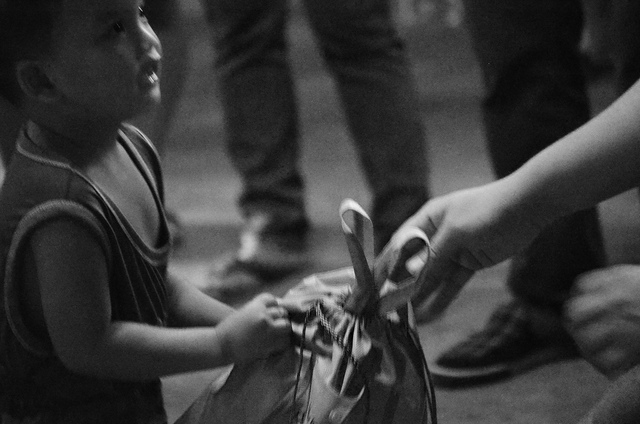
Every time we have an opportunity to go back to our home country, the Philippines, I try to give back as much as I can. We also try to schedule our travel around the Christmas and New Year season because it’s like a pilgrimage for every Filipino living overseas. It’s the season of getting together as a family and, most important of all, GIVING. Our alumni association based in Singapore – the University of the Philippines Alumni Association (Singapore) – has an annual community program called Pamaskong Pambata. Thru the program, the group partners with a local non-profit organizations that focus on the welfare of children and it becomes the beneficiary for the year. I take this opportunity to teach my kids about the value of community work while at the same time opening their eyes to the living conditions of our less fortunate countrymen. In 2007, my youngest son and I joined the community program as they partnered with an orphanage. As a 3-year-old, my son had the opportunity to distribute food and gifts to kids much older than him. One thing he remembered vividly was putting on a Santa hat as he started giving gifts. He still remembers how each recipient had immediately put on a smile as they received the gift he was giving.
This time around, I took my eldest son with me on this trip. I was informed that the location for this year’s community work was in Payatas in Quezon City. Payatas happens to be the main area for garbage disposal in Manila. Most of the people here make their living by collecting and selling recyclable garbage from the dump.
It’s easy to teach kids (and adults) lessons on gratitude and the importance of properly managing one’s resources. We can talk about it in the dinner table or even in the board room when we want to emphasize operational efficiency in the company. Internal memos, emails and parental nagging may end up being ignored and not get the results we want. But to really drive the message across, we need to create an environment for learning. And not just learning thru theory and concepts but something that they will always remember. Here are few ideas that you can use to achieve the results you want:
- Put it in their calendar. As early as November, I’ve already made arrangements to join the community outreach program. There were slight changes in the date but I made sure I update my calendar. I told my son about the schedule so that he can make the necessary preparations. Creating an environment for learning requires telling the people involved that it has to be on their schedule as well.
- Engage their emotions. Theoretical and conceptual learning only lasts for a while. Emotional learning creates an impact. I bet you remembered a very important lesson that your parents or friends told you because of the experience associated with it. As we were heading to the meeting place, I kept showing my son the difference between our house and the ones he’s seeing along the way. He did see several kids playing near the dumps, most of them don’t even have anything to protect their feet. It’s priceless to see the look on someone else’s eyes (both kids and adults alike) as they see other people searching thru the garbage to find food that they immediately take in. That experience immediately teaches them the deeper meaning of gratitude.
- Tap in to their passion. My kids have different personalities. While my youngest son would enjoy engaging with people, my eldest is a bit timid. I thought about how he can make the most out of this trip. Then, I realized that he likes taking photos and videos. I told him to charge up his iPod and be ready to snap photos. I also let him take charge of my DSLR camera. Since I already taught him the basics of digital photography (I’m still learning myself), I was confident that he’d do a great job. And he did. As I was distributing food to the kids, he was taking as much photos as he can. It was easier for me to engage him in the moment because he was having fun with what he was doing.
- Re-tell the experience. The day with my son ended up with a trip to my alma mater. As we were enjoying a great snack, I asked him about the experience. I also told him some of those “remember when…” stories: “Remember when we couldn’t even buy you an ice cream cone?” We’ve told him this story several times but this time was different. Because now he has seen kids that are younger than him who can’t even afford to go to school, who need to scour the dumps in order to have something to eat and who think having an ice cream cone is a luxury. The lessons and stories we used to tell him now made more sense because of his personal experience.
Whether you’re teaching a lesson to a kid or an adult, it is important to make sure that the lessons do stick. Because it’s not just about teaching them lessons, it’s about creating memorable experiences.
Question: What is that one lesson that stuck with you? Did it come with a memorable experience?
Please note: I reserve the right to delete comments that are offensive or off-topic.